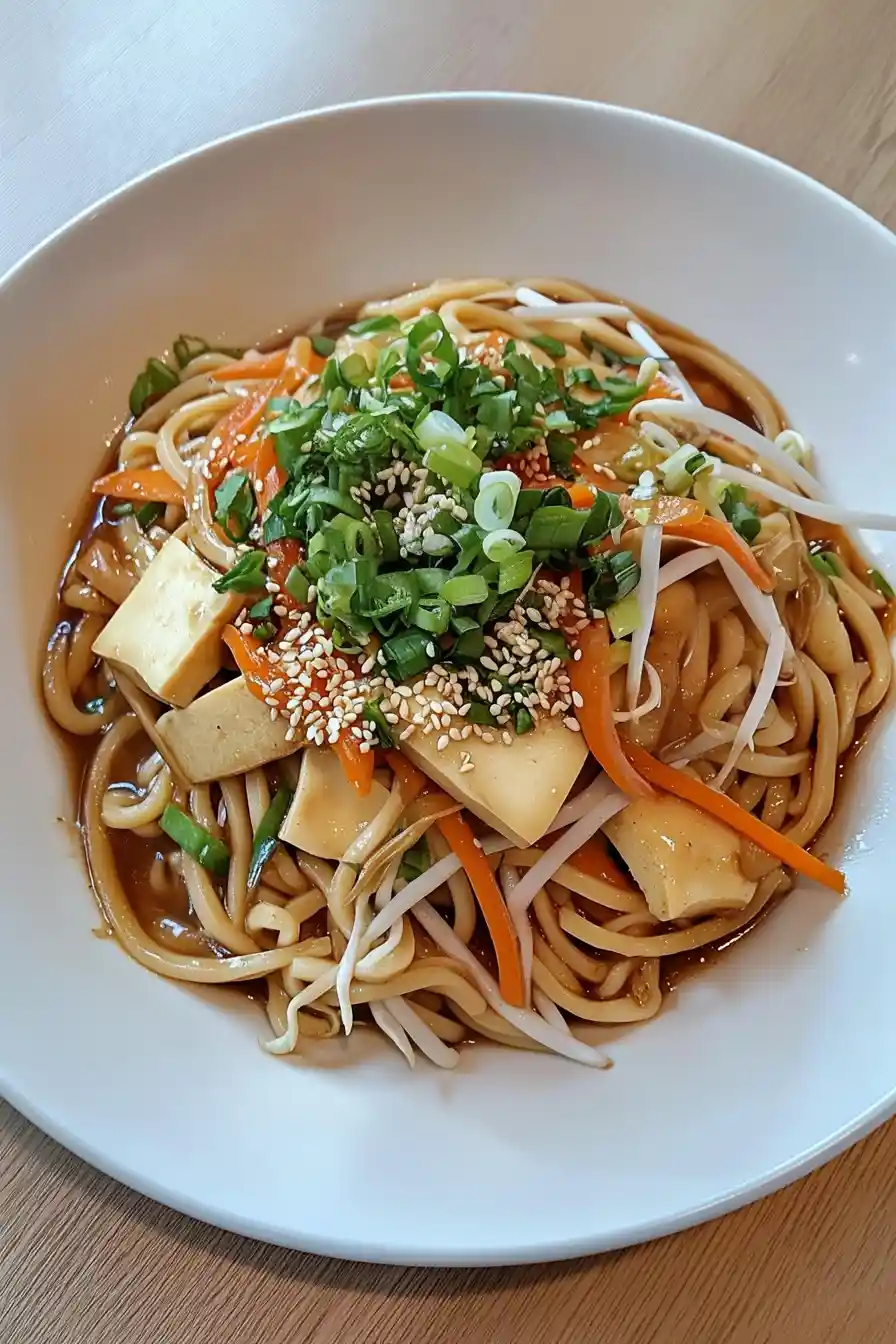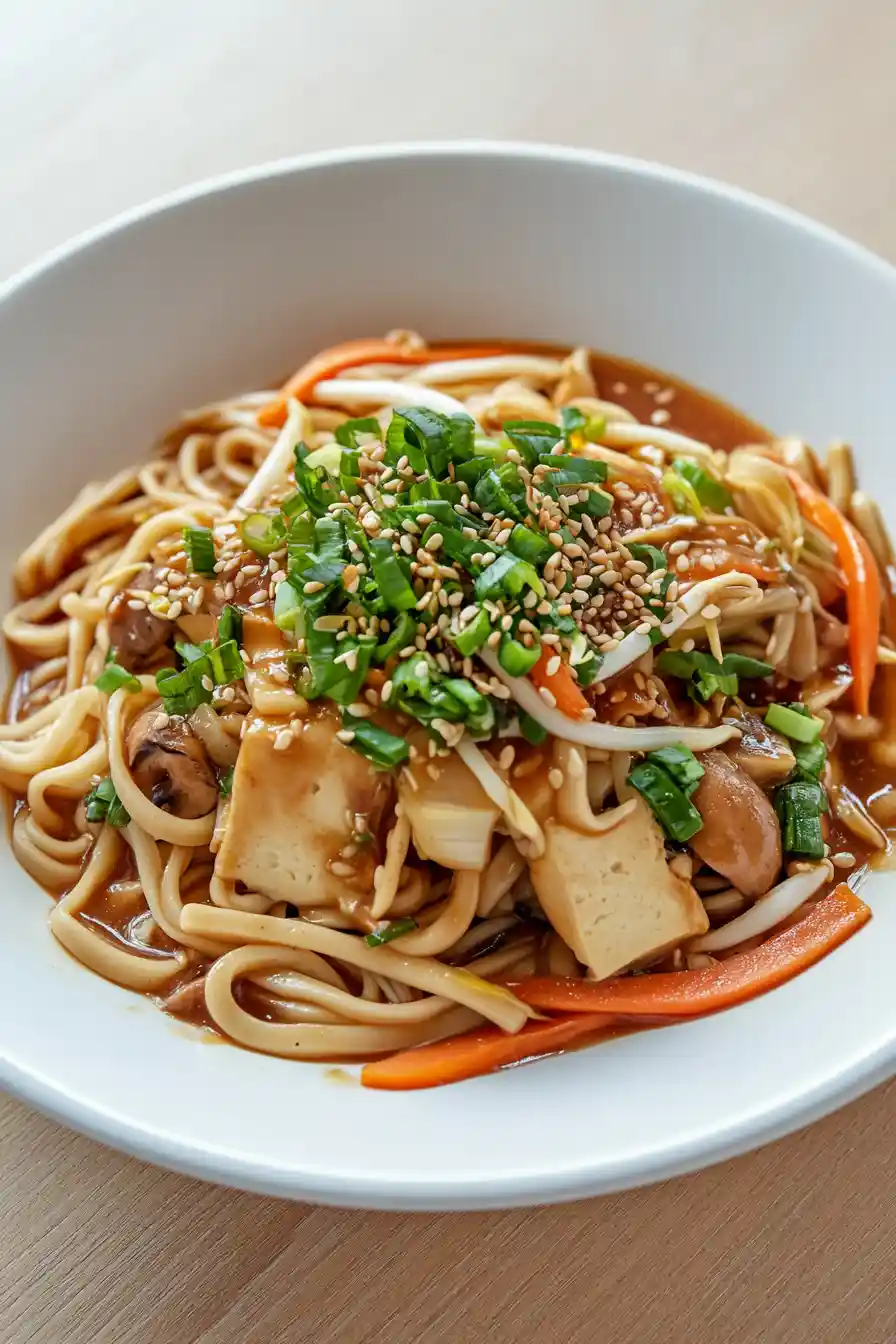If you ask me, yakisoba is one of those comfort foods that just makes sense.
This Japanese-style stir-fried noodle dish brings together crispy vegetables and chewy noodles in a way that feels both familiar and fresh. The savory sauce coats everything with just the right balance of sweet and salty flavors.
It’s loaded with mushrooms, cabbage, and carrots, all cooked until they’re perfectly tender but still have a nice bite to them. The noodles get slightly crispy on the edges as they cook in the pan, which might be my favorite part.
It’s the kind of meal that works for busy weeknights, and even picky eaters tend to clean their plates.

Why You’ll Love This Yakisoba
- Plant-based satisfaction – This meatless version of the classic Japanese noodle dish is packed with tofu and vegetables, making it perfect for vegetarians or anyone looking to eat more plant-based meals.
- Customizable heat level – You can keep it mild or spice it up with optional hot sauce – making it perfect for both sensitive and adventurous taste buds.
- Pantry-friendly ingredients – Most of these ingredients are easy to find at regular grocery stores, and many are likely already in your kitchen.
- Complete meal in one pan – With protein from tofu, vegetables for nutrients, and noodles for energy, you’ve got all your nutritional bases covered in a single dish.
- Perfect leftovers – These noodles taste great the next day, making them ideal for meal prep or packed lunches.
What Kind of Tofu Should I Use?
Extra-firm tofu is definitely the way to go for this yakisoba recipe, but you’ll still want to press it properly before cooking. Regular or firm tofu contains too much moisture and can fall apart during stir-frying, while silken tofu would completely crumble. To get the best results, press your extra-firm tofu between paper towels with a heavy object on top for about 15-30 minutes before cooking – this removes excess moisture and helps it get nice and crispy in the pan. If you’re in a hurry, you can also buy “super-firm” tofu, which comes pre-pressed and ready to use.

Options for Substitutions
This veggie-packed noodle dish is pretty adaptable! Here are some handy swaps you can try:
- Extra firm tofu: You can swap tofu with tempeh or seitan for a different protein option. If using tempeh, steam it for 10 minutes first to soften it up.
- Udon noodles: While udon gives this dish its signature chew, you can use soba noodles, thick Chinese wheat noodles, or even regular spaghetti in a pinch. Just cook them slightly less than package directions since they’ll finish cooking in the pan.
- Napa cabbage: Regular green or savoy cabbage works just fine here. You might need to cook it a minute or two longer since it’s slightly tougher than napa.
- Button mushrooms: Any mushroom variety works great – try shiitake, cremini, or oyster mushrooms. Each will add its own nice flavor to the dish.
- Bean sprouts: If you can’t find fresh bean sprouts, try julienned carrots, snow peas, or even thinly sliced celery for that fresh crunch.
- Rice vinegar: Apple cider vinegar or white wine vinegar can work too – just use a bit less as they’re slightly stronger.
Watch Out for These Mistakes While Cooking
The biggest challenge when making vegetarian yakisoba is dealing with watery tofu, which can make your stir-fry soggy – press your extra firm tofu between paper towels with a heavy weight on top for at least 30 minutes before cooking to remove excess moisture. Another common mistake is overcrowding the pan with vegetables, which leads to steaming instead of the desired crispy stir-fry effect – cook your vegetables in batches if needed, and keep the heat high enough to get a nice sear. The noodles can easily clump together or break apart if not handled properly – to prevent this, gently separate them before cooking and stir-fry them quickly but carefully, adding the sauce gradually rather than all at once. For the best texture and flavor, make sure to prep all ingredients before starting to cook, as this dish comes together quickly and leaving ingredients in the pan too long can make them mushy.

What to Serve With Vegetarian Yakisoba?
This noodle dish is pretty filling on its own, but there are some great Japanese-inspired sides that make it even better! A simple cucumber salad with rice vinegar and sesame seeds adds a cool, crisp contrast to the warm noodles. You might also want to serve some edamame on the side – they’re perfect for snacking while you eat, and they add extra protein to the meal. For a complete spread, include a small bowl of miso soup and maybe some pickled vegetables (like Japanese-style pickled radish or cucumber) to add different flavors and textures to your plate.
Storage Instructions
Keep Fresh: Place your leftover yakisoba in an airtight container and pop it in the fridge – it’ll stay good for up to 3 days. The noodles might absorb more sauce over time, but that just means they’ll be extra flavorful! Just keep in mind that the bean sprouts might lose some of their crunch.
Prep Ahead: You can cut all the veggies and tofu up to a day ahead and store them separately in the fridge. This makes dinner assembly super quick when you’re ready to cook! Just wait to cook the noodles until you’re ready to serve, as they taste best fresh.
Warm Up: To enjoy your leftover yakisoba, heat it in a pan over medium heat with a splash of water to prevent sticking. Give it a good stir while heating to make sure everything warms evenly. A quick 2-3 minutes in the pan will bring it back to life, and you can add a dash of soy sauce if needed to refresh the flavors.
| Preparation Time | 15-20 minutes |
| Cooking Time | 35-40 minutes |
| Total Time | 50-60 minutes |
| Level of Difficulty | Medium |
Estimated Nutrition
Estimated nutrition for the whole recipe (without optional ingredients):
- Calories: 600-700
- Protein: 30-35 g
- Fat: 20-25 g
- Carbohydrates: 80-90 g
Ingredients
- 175g extra firm tofu
- Pinch of salt and pepper
- 1 piece garlic
- 1 stick green onion
- 1/4 lb button mushrooms
- 1/4 carrot
- 3 large leaves napa cabbage
- 2 tbsp soy sauce
- 1 tbsp rice vinegar
- 1 tsp toasted sesame oil
- 2 tbsp ketchup
- 1 bundle udon noodles
- Drizzle of olive oil
- Small bunch bean sprouts
- 1/2 tbsp white sesame seeds
- (optional hot sauce)
Step 1: Prepare and Bake the Tofu
Begin by preheating your oven to 375°F (190°C).
Pat dry 175g of extra firm tofu with a paper towel, then slice it into strips or cubes according to your preference.
Line a baking tray with parchment paper and spread the tofu across it.
Season with a pinch of salt and pepper to taste.
Bake the tofu in the preheated oven for 25 minutes until it’s golden and slightly crispy.
Step 2: Prep the Vegetables
While the tofu is baking, finely slice 1 piece of garlic.
Chop 1 stick of green onion, keeping the white and green parts separate for later use.
Half 1/4 lb of button mushrooms and finely chop 1/4 of a carrot into matchsticks.
Roughly chop 3 large leaves of napa cabbage.
Step 3: Cook the Noodles
Bring a pot of water to a boil for the udon noodles.
While waiting for the water to boil, prepare a quick sauce in a small bowl by combining 2 tablespoons of soy sauce, 1 tablespoon of rice vinegar, 1 teaspoon of toasted sesame oil, and 2 tablespoons of ketchup.
Stir the mixture well to combine.
When the water reaches a rolling boil, add the udon noodles and cook them for half the time indicated on the package, approximately 4 minutes.
Strain the noodles and reserve 1/2 cup of the cooking water for later.
Step 4: Sauté the Vegetables and Tofu
Once the tofu has finished baking, heat a sauté pan over medium-high heat and add a drizzle of olive oil.
Begin by adding the white parts of the green onion and the sliced garlic to the pan, followed by the chopped napa cabbage.
Sauté the mixture for 2-3 minutes until the cabbage begins to soften.
Next, add the mushrooms, carrots, and about half of the baked tofu to the pan.
Continue sautéing for an additional minute until the vegetables and tofu are well coated and heated through.
Step 5: Combine Ingredients
Introduce the boiled udon noodles to the pan along with the prepared sauce, reserved cooking water, and a small bunch of bean sprouts.
Sauté everything together for a few minutes until the noodles absorb the sauce and all ingredients are evenly distributed and heated through.
Step 6: Serve and Garnish
Transfer the noodle and tofu stir-fry to serving plates.
Garnish each plate with the green parts of the green onion and sprinkle with white sesame seeds for added flavor and texture.
If you enjoy some heat, consider serving your dish with a side of homemade hot sauce for an optional but delicious spicy kick.

